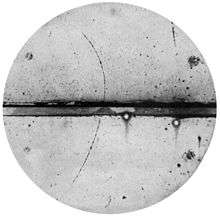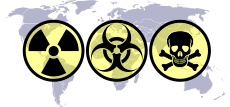Antimatter weapon
| Antimatter |
|---|
 |
|
Bodies |
| Weapons of mass destruction |
|---|
 |
| By type |
| By country |
|
| Proliferation |
| Treaties |
|
An antimatter weapon is a possible device according to theories using antimatter as a power source, a propellant, or an explosive for a weapon. Antimatter weapons cannot yet be produced due to the current cost of production of antimatter (estimated at 63 trillion dollars per gram) given the extremely limited technology available to create it in sufficient masses to be viable in a weapon, and the fact that it annihilates upon touching ordinary matter, making containment very difficult.
The paramount advantage of such a theoretical weapon is that antimatter and matter collisions result in the entire sum of their mass energy equivalent being released as energy, which is at least an order of magnitude greater than the energy release of the most efficient fusion weapons (100% vs 7-10%). Annihilation requires and converts exactly equal masses of antimatter and matter by the collision which releases the entire mass-energy of both, which for 1 gram is ~1.8×1014 joules. Using the convention that 1 kiloton TNT equivalent = 4.184×1012 joules, one gram of antimatter reacting with one gram of ordinary matter results in 42.96 kilotons-equivalent of energy (though there is considerable "loss" by production of neutrinos).
Acquiring and storing antimatter
Antimatter production and containment are currently impenetrable barriers (due to current technological limitations) to the creation of antimatter weapons. Quantities measured in grams will be required to achieve a destructive effect comparable with conventional nuclear weapons.
Currently, the few known physics reactions for producing antimatter involve particle accelerators or particle bombardment, but are both currently highly inefficient and prohibitively expensive. The global production rate per year is only 1 to 10 nanograms.[1] In 2008, the annual production of antiprotons at the Antiproton Decelerator facility of CERN was several picograms at a cost of US$20 million. Thus, at the current level of production, an equivalent of a 10 Mt hydrogen bomb, about 250 grams of antimatter will take 2.5 billion years of the energy production of the entire Earth to produce.[2] A milligram of antimatter will take 100,000 times the annual production rate to produce (or 100,000 years).[3] For example, an equivalent of the Hiroshima atomic bomb would take half a gram of antimatter, but would take CERN two million years to produce at the current production rate.[2]
Since the first creation of artificial antiprotons in 1955, production rates increased nearly geometrically until the mid-1980s; A significant advancement was made recently as a single antihydrogen atom was produced suspended in a magnetic field. Physical laws such as the small cross-section of antiproton production in high-energy nuclear collisions make it exceedingly difficult to improve the production efficiency of antimatter given current technology.
Recent advances & physics obstacles
Research conducted in 2008 dramatically increased the quantity of positrons (antielectrons) that can be produced. Physicists at the Lawrence Livermore National Laboratory in California used a short, ultra-intense laser to irradiate a millimetre-thick gold target which produced more than 100 billion positrons.[4][5][6]
Even if it were possible to convert energy directly into particle/antiparticle pairs without any loss, a large-scale power plant generating 2000 MWe would take 25 hours to produce just one gram of antimatter. Given the average price of electric power of around US$50 per megawatt hour, this puts a lower limit on the cost of antimatter at $2.5 million per gram.[7] They suggest that this would make antimatter very cost-effective as a rocket fuel, as just one milligram would be enough to send a probe to Pluto and back in a year, a mission that would be completely unaffordable with conventional fuels. By way of comparison, the cost of the Manhattan Project (to produce the first atomic bomb) is estimated at US$23 billion in 2007 prices.[8] Most scientists, however, doubt whether such efficiencies could ever be achieved.
The second problem is the containment of antimatter. Antimatter annihilates with regular matter on contact, so it would be necessary to prevent contact, for example by producing antimatter in the form of solid charged or magnetized particles, and suspending them using electromagnetic fields in a near-perfect vacuum. The obvious solution of confining a charged object inside a similarly charged container is not feasible as the electric field inside is uniform. For this reason it is necessary to have charged objects moving relative to the container which can be confined to a central region by magnetic fields; for example, in the form of a toroid or Penning trap (see below).
In order to achieve compactness given macroscopic weight, the overall electric charge of the antimatter weapon core would have to be very small compared to the number of particles. For example, it is not feasible to construct a weapon using positrons alone, due to their mutual repulsion. The antimatter weapon core would have to consist primarily of neutral antiparticles. Extremely small amounts of antihydrogen have been produced in laboratories, but containing them (by cooling them to temperatures of several millikelvins and trapping them in a Penning trap) is extremely difficult. And even if these proposed experiments were successful, they would only trap several antihydrogen atoms for research purposes, far too few for weapons or spacecraft propulsion. Heavier antimatter atoms have yet to be produced.
The difficulty of preventing accidental detonation of an antimatter weapon may be contrasted with that of a nuclear weapon. Whereas nuclear weapons are 'fail-safe', antimatter weapons are inherently 'fail-deadly': In an antimatter weapon, any failure of containment would immediately result in annihilation, which would damage or destroy the containment system and lead to the release of all of the antimatter material, causing the weapon to detonate entirely at full yield. By contrast, a modern nuclear weapon will explode with a significant yield if (and only if) the nuclear trigger is fired with absolute precision resulting in a neutron source wholly releasing promptly (< microseconds). In short, an antimatter weapon must be actively kept from detonating; whereas a nuclear weapon will not unless deliberately made to do so.
Cost
As of 2004, the cost of producing one millionth of a gram of antimatter was estimated at US$60 billion.[9]
Smaller weapons are more economically feasible: A modern MK3 hand grenade contains 227 g of TNT.[10] One billionth of a gram of positrons contains as much energy as 37.8 kilograms (83 pounds) of TNT,[9] making the 2004 cost of "positron hand grenade" (10 trillionth of a gram of antimatter, 378 g TNT equivalent) that could be fitted in a sniper's bullet US$600,000. This excludes the cost of the micro containment device if such a thing is possible.
Antimatter catalyzed weapons
Antimatter-catalyzed nuclear pulse propulsion proposes the use of antimatter as a "trigger"[11] to initiate small nuclear explosions; the explosions provide thrust to a spacecraft. The same technology could theoretically be used to make very small and possibly "fission-free" (very low nuclear fallout) weapons (see pure fusion weapon).[12][13] Antimatter-catalyzed weapons could be more discriminate and result in less long-term contamination than conventional nuclear weapons, and their use might therefore be more politically acceptable.
References
- ↑ "Antimatter Production for Near-term Propulsion Applications" (PDF). Archived from the original (PDF) on 2007-03-06.
The cost of producing large quantities of antimatter (i.e., gram-scale or above) with current facilities is exceedingly high.
- 1 2 "Angels and Demons". CERN. Archived from the original on 2012-01-05.
- ↑ Antimatter FAQ Archived 2011-03-21 at the Wayback Machine.
- ↑
Bland, E. (1 December 2008). "Laser technique produces bevy of antimatter". MSNBC. Archived from the original on 5 December 2008. Retrieved 2009-07-16.
The LLNL scientists created the positrons by shooting the lab's high-powered Titan laser onto a one-millimeter-thick piece of gold.
- ↑ "Lasers creates billions of antimatter particles". Cosmos Online. Archived from the original on 2009-05-22.
- ↑ "Billions of particles of anti-matter created in laboratory". Lawrence Livermore National Laboratory. Archived from the original on 2016-03-10. Retrieved 2016-03-09.
- ↑ "U.S. Energy Information Administration (EIA)". www.eia.gov. Archived from the original on 28 January 2018. Retrieved 4 May 2018.
- ↑ "Manhattan Project". Archived from the original on 28 December 2014. Retrieved 17 January 2015.
- 1 2 "Air Force pursuing antimatter weapons / Program was touted publicly, then came official gag order". San Francisco Chronicle. Archived from the original on 29 December 2014. Retrieved 17 January 2015.
- ↑ Dockery, Kevin (2004). Weapons of the Navy SEALs. New York: Berkley Publishing Group. p. 237.
- ↑ "Antimatter weapons". cui.unige.ch. Archived from the original on 24 April 2013. Retrieved 4 May 2018.
- ↑ Ramsey, Syed (12 May 2016). "Tools of War: History of Weapons in Modern Times". Vij Books India Pvt Ltd. Archived from the original on 16 August 2017. Retrieved 4 May 2018 – via Google Books.
- ↑ "Details on antimatter triggered fusion bombs - NextBigFuture.com". nextbigfuture.com. 22 September 2015. Archived from the original on 22 April 2017. Retrieved 4 May 2018.
External links
- Spotlight on "Angels and Demons" – A discussion at CERN's public website on the viability of the use of antimatter for energy and weaponry
- "Air Force pursuing antimatter weapons: Program was touted publicly, then came official gag order"
- Page discussing the possibility of using antimatter as a trigger for a thermonuclear explosion
- Paper discussing the number of antiprotons required to ignite a thermonuclear weapon